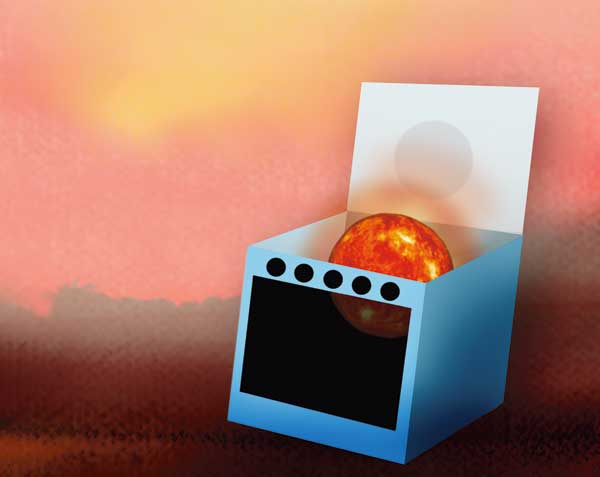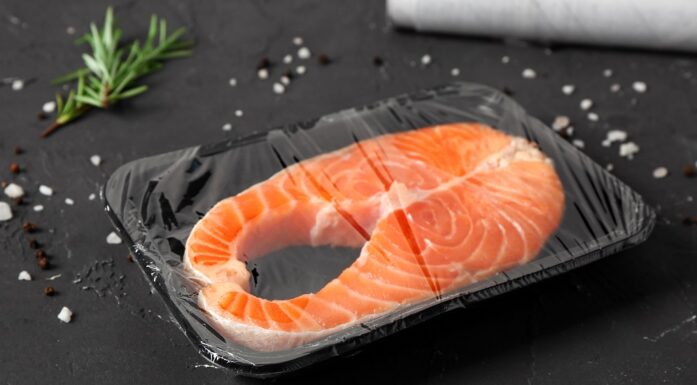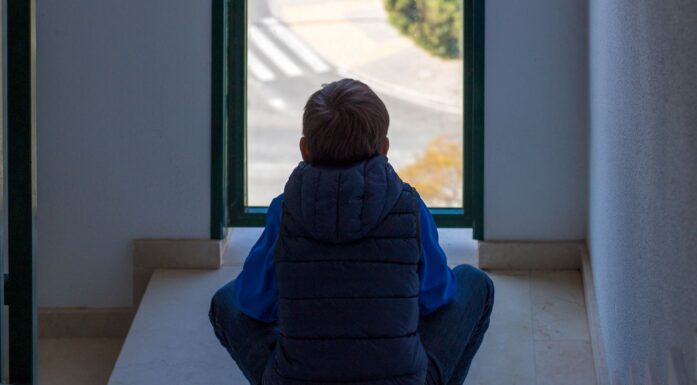Catching rays for supper
Preheat your oven might mean simply putting it out in the sun.
Can our society move beyond the use of coal, oil and gas? The answer from researchers at the Norwegian University of Science and Technology is a resounding yes.
Habtamu Bayera Madessa came from Ethiopia to Norway to develop solar-powered technology for his homeland. His goal is to construct a simple, cheap and safe oven that both collects and stores heat from the sun.
Parabolic dish captures sun
There is not much natural sunlight shining through the windows of a cold Trondheim workshop on a January morning. We have come to see the prototype for a solar oven. But the sun has taken its winter holiday, and is of no help. Habtamu is not alarmed by that and turns on a wall of enormous floodlights. They will serve nicely as the local sun.
The oven does not look at all like an oven. It is a silver-coloured barrel that is waist-high. The silver barrel has a stone core and is insulated with many layers of rock wool. On the top is a cooking plate. The oven is connected to an aluminium pipe that has a moveable aluminium parabolic dish on the other end.
”We’re capturing the sun here,” says Habtamu, pointing to the one-and-a-half metre parabolic dish covered with small mirrors. It works like this: the dish reflects the suns rays and focuses them on a fibre mat of polished steel wool. The mat is attached to the end of the pipe that connects the parabolic dish to the oven.
It is the air that is drawn though this fibre mat that transports the sun’s energy to small stones in the centre of the oven that store the heat. The cooking plate makes contact with the stored heat via an aluminium plate that is fixed in the stones and carries the heat upwards.
World’s first
Habtamu is a PhD candidate at NTNU. The prototype oven he is now design- ing with other researchers at the Department for Energy and Process Engineering is the first that both collects solar heat and maintains cooking temperatures for more than 24 hours.
In Habtamus’ homeland, electricity is a luxury limited to the large cities. In rural areas, the solar oven opens the possibility of being able to cook food after sunset. It can warm a house, boil water and help to improve hygiene. The local hospital will see a dramatic improvement in its standards with sterile medical equipment. Currently, patients have to bring wood with them for heating water.
Storage is the problem
“The difficulty isn’t to get the oven to reach 400° C,” explains Habtamu, “but to store the heat. The oven has to maintain a temperature of 250° C for more than 24 hours after it is heated for us to be satisfied. That’s what is needed to cook food.”
Making something like this out of modern materials is easy, according to this researcher. The more difficult challenge is finding simple materials.
“We use high technology approximations to find the best combination of the simplest and most easily available materials. The technology can be developed so that it can be built on a larger scale for electricity production. The solar oven functions like an energy source that can be operated 24 hours a day. This could be the future’s most important energy source,” he concludes.
Out of poverty?
The solar oven is a result of a 10-year collaboration involving a number of African universities, the Norwegian Agency for Development Cooperation (Norad) and NTNU. This particular prototype is based on a concept developed by Actor Chikukwa from Zimbabwe, who was recently awarded a PhD by NTNU’s Department of Physics.
The physicist and the initiator of the research project, Jørgen Løvseth, believes that this kind of energy collector can help lift Africa out of poverty, without destroying the environment.
“This is all about taking underdeveloped countries and their challenges seriously,” he says. “First, people have to have food and heat, and a public health service that can sterilize its medical equipment.
The solar oven can make an important contribution to that. We are developing a technology that will enable many Africans to develop their own communities, and lift themselves out of poverty. And all this, without affecting the environment. The technology also can be the foundation for small and large-scale industry.”
Burning glass effect
Professor Løvseth explains why this kind of oven has not already been invented. “The sun as an energy source has been used relatively little by the world. In most places, the sun could easily supply the demand for heating and with a little bit of development, the cooling demands as well.
But the Industrial Revolution started in a place where there isn’t much sun and was based on coal, and later oil and natural gas. These energy sources are now creating a climate catastrophe, they’re shrinking in importance, and we have to think in new ways.”
“We can collect solar energy in two ways,” he adds, “via solar cells that make electricity, or as heat, as we’ve done in this solar oven. Concentrated systems that use heat need dir- ect sun and provide a high temperature. We call it the ‘burning glass effect’. The heat can be used directly, for industry or in producing electricity. This is already being done in places where there is a lot of sun, such as California and Spain.”
More effective than solar cells
The project also involves measuring and analysing the sun’s light and radiation in different parts of Africa. The goal is to find the best places for large-scale solar heating equipment for national power stations in Ethiopia, Uganda and Mozambique.
“The direct use of solar heat is much more effective than the use of solar cells,” Professor Løvseth explains. “To use solar energy from solar cells, we have to go through a number of steps, and for each step we lose quite a bit of the original energy. If we could capture the sun’s energy in the Sahara in this direct way, there would be more than enough energy for 10 billion people consuming energy at the same level as the USA, and there wouldn’t be any CO2 emissions.”
By Hege J. Tunstad





